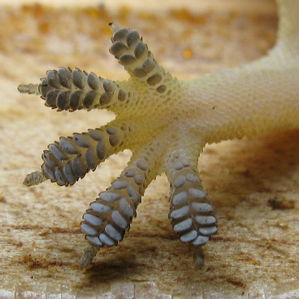A Strapless Bra That’s as Sticky as Gecko Feet
What do 19th century Dutch physicist Johannes Diderik van der Waals and women’s undergarments have in common? If you answered “gecko feet,” congratulations. You’re as big a nerd as mechanical engineer Anthony Roy.

The story, as brought to us by Gizmodo’s science editor Jennifer Oulette, is that Roy heard his wife’s cry for a strapless bra that actually stays up and decided to take matters into his own hands. (I’ve always wondered why major engineering schools like Roy’s Caltech or MIT don’t seem to have anyone dedicated to solving the problems of poor bra design. Perhaps it’s reflective of the gender imbalance in STEM?)
This is where the geckos come in. They’re a family of lizards notable because some members have the ability to cling superheroically to almost any surface. At the microscopic level, the pads on their toes are bristling with tiny hairlike structures. This matters because of the intermolecular force proposed by (and subsequently named after) Frans van der Waals. Oulette explains:
In 2000, University of California, Berkeley, physicist Robert Full realized that this strong adhesion came about because of Van der Waals forces between molecules. These forces are usually not significant, but become [significant] at very small micro- and nano-scales.
By maximizing the surface area of the gecko’s feet, these microscopic structures also maximize the number of molecules able to attract one another with these weak van der Waals forces. Weak individually, these forces become powerful in aggregate; powerful enough to hold up several ounces of insectivorous lizard or satiny fabric.
Ever since the secret to geckos’ stickiness was described, engineers have been trying to re-create it for human use. “In particular,” Oulette writes, “Roy recalled a robotic design by scientists at NASA’s Jet Propulsion Laboratory designed around the gecko’s foot. Thus his own GeckTech was born: a small patch that sticks to the skin via that same physical mechanism.”
Even better, the clinging effect is as harmless and painless to human skin as static cling is to socks (and no shock, to boot).
Roy made the first prototypes a few years ago by supergluing some of his “GeckTeck” material into his wife’s strapless bras. (“I knew I had truly struck gold,” Roy writes on the Kellie K site, “when one night we were going out and instead of using one of her store-bought bras, she grabbed the prototype. At that moment I realized I truly had a great idea for a business.”)
As of last night, Roy’s company had just eked out a successful Phase 2 Kickstarter. Backers can expect their bras in April 2016.
Keep Reading
Most Popular
Large language models can do jaw-dropping things. But nobody knows exactly why.
And that's a problem. Figuring it out is one of the biggest scientific puzzles of our time and a crucial step towards controlling more powerful future models.
How scientists traced a mysterious covid case back to six toilets
When wastewater surveillance turns into a hunt for a single infected individual, the ethics get tricky.
The problem with plug-in hybrids? Their drivers.
Plug-in hybrids are often sold as a transition to EVs, but new data from Europe shows we’re still underestimating the emissions they produce.
Google DeepMind’s new generative model makes Super Mario–like games from scratch
Genie learns how to control games by watching hours and hours of video. It could help train next-gen robots too.
Stay connected
Get the latest updates from
MIT Technology Review
Discover special offers, top stories, upcoming events, and more.